Asian hornet week
Synopsis : The Asian hornet is here, perhaps to stay. Be vigilant and report any sightings as it will have a big impact on our bees and beekeeping.
Introduction
Beekeeping involves observation, and good beekeeping requires good observation.
As the late, great, Yogi Berra said:
You can observe a lot by watching
It’s not just a case of looking, you have to see and interpret things as well.
What’s happening in the hive?
What’s not happening that should be happening?
Is anything significant new or unusual?
And these observations should not just be restricted to the times you are elbow deep in the brood box. Start on your way to the apiary … in fact, keep an eye on things all the time. What’s flowering, is it early or late? Have the migrant birds arrived (or left) yet?
I’ve mentioned phenology previously and, if you apply yourself, you get to appreciate the rhythm of the seasons.
And sometimes you see completely new things … to you or your environment. These probably indicate gradual – or potentially dramatic – changes to the environment that your bees share.
Climate change and environmental change
I’ve got a buddleja (butterfly bush) in my west coast apiary. It’s one of the few things not eaten by the damn deer. As soon as it starts flowering it’s visited by hordes of Red Admiral and Tortoiseshell butterflies, as well as loads of bees and syrphids (hover flies). Interestingly, I almost never see Scotch Argus butterflies on the buddleja.
While in the apiary a fortnight ago I noticed an unusual butterfly flitting around the buddleja. It was a Comma, a species widespread in England but very much rarer north of the central belt in Scotland. According to the NBN (National biodiversity network) atlas there are only a handful of records north of the Great Glen, all – until two weeks ago – east of my apiary.
A hundred years ago the Comma was restricted to the South West and Welsh borders. Its range is now expanding North by about 10 km a year due to climate change. The Speckled Wood, another butterfly I’ve seen for the first time here this summer, is also moving north – albeit more slowly – again due to climate change.
But not all environmental changes are due to climate change. Some are due to direct human activity, such as the deliberate or accidental introduction of new species due to globalisation.
And, if I was in southern England (or, to keep my American readers engaged, Georgia), the thing I’d be looking out for is the Asian, or yellow-legged, hornet.
Asian hornet
The Asian hornet (Vespa velutina) is an invasive mid-sized hornet that predates other insects, including very large numbers of honey bees.
The Asian hornet was inadvertently introduced (as one or more overwintering queens) to France in 2004 with a batch of pottery from China. It has subsequently spread widely across France, Spain, Belgium, Portugal and Italy. You can view the distribution by 2019 – essentially all of France, parts of northern Spain, most of northern Portugal – on this Google map.
It’s pretty obvious that conditions in much of Europe suit the Asian hornet well and I would expect that it will continue to spread to other areas where the temperature, humidity and altitude are suitable.
And, of relevance to UK beekeepers, large areas of central and southern England are suitable 🙁 .
Life cycle
The Asian hornet is a social wasp. Unlike honey bees, the mated queen overwinters alone, hibernating in a protected location until the spring arrives.
In the spring the queen emerges from hibernation and starts building the embryo, or primary, nest. This nest is relatively small and only increases in size slowly. Eggs laid in this nest develop into female workers and the development time is prolonged (~50 days) meaning that colony expansion is slow.
Later in the season the development time drops to ~29 days and the embryo nest either expands faster or is relocated. Mature secondary nests are large and may have ~13,000 cells that produce ~25,000 hornets during the season.
The colony size peaks in mid/late autumn at which time the reproductive males and females (the latter are often termed ‘gynes’ meaning ”the fertile female in a colony of social insects”) are produced. A single nest can produces 350 gynes.
The female mates with 2.5-4 males and these new foundresses abandon the nest. The colony goes into decline and the population drops, but can remain active late into the year.
There are large gaps in our knowledge of the biology of Asian hornets, and even larger gaps {{1}} in my knowledge of them.
Is colony fitness and reproductive success influenced by the number of males that the queen mates with? If so, low colony densities and/or cold autumns may restrict population expansion the following season.
What are the minimum temperatures required for queen mating? This will significantly influence the northward expansion of the population. At some point – latitude or altitude – mating will be unlikely and population expansion will falter.
Here, now?
I’ve written just three posts specifically on the Asian hornet to date, all in 2016 or 2017. Interestingly, the most read of these this year accounts for just 0.02% of page reads.
Clearly, despite the current near saturation coverage in the UK press, readers of this site aren’t too energised to look at the literature that’s out there … or perhaps they’re put off by the word ’extrapolating’ in the post’s title?
Specifically that post (‘Extrapolating Asian hornets’) was about predicting the likely rate of spread and distribution of Asian hornets from an initial incursion in Gloucestershire. The rate of spread and final distribution are probably still broadly valid, though it appears as though Kent is where this species is establishing – or has established – a foothold.
Between 2016 and 2022 there were – according to UK government statistics – 24 hornet sightings and 13 nests destroyed. The government appear to have abandoned updating that last link on the 22nd of August {{2}}.
Current numbers for 2023 – according to the rolling updates from the National Bee Unit – show numerous sightings and 37 nests destroyed.
The first nest identified in 2023 – an embryo nest – was on the 22nd of June near Dover in Kent. My reading of the reports suggests that all but about half a dozen of the nests subsequently identified and destroyed this year are in Kent.
Incursions or an established population?
Formally, it’s too soon to declare that the Asian hornet is established {{3}} in the UK, as opposed to its presence being due to repeated incursions from continental Europe.
However, before the genetic data confirms that nests originate from sister queens, the geographic clustering of nests in northern and eastern Kent (including Deal, Whitstable, Folkestone, Gravesend, Canterbury and Maidstone) suggests to me that the Asian hornet is probably now established in the UK.
Dave Goulson (University of Sussex) was recently quoted as saying that it was likely that the Asian hornet was established in Kent.
The official line remains as follows (quote from Nicola Spence, DEFRA):
“Evidence from previous years suggested that all 13 Asian hornet nests found in the UK between 2016 and 2022 were separate incursions and there is nothing to suggest that Asian hornets are established in the UK. We have not seen any evidence which demonstrates that Asian hornets discovered in Kent this year were produced by queens that overwintered. We plan to do further detailed analysis over winter to assess this.”
I’m afraid, considering the distance to the continent and the (Brexit-notwithstanding) cross-Channel trade and tourism, it’s a case of “When, not if?” where the establishment of Asian hornets in the UK is concerned. I’ve considered it an inevitability since the hornet spread so widely and so fast in France.
Even if all the nests destroyed in 2023 turn out to be unrelated and due to incursions, the Asian hornet will become established in the UK next year, or the year after, or soon after that 🙁 .
Population expansion
But that doesn’t mean that attempts should not be made to identify nests and destroy them.
Data from Jersey and La Manche in Normandy shows the rate at which nest numbers increase over a relatively short period (2016 – 2022). The areas of these two regions are very different – Jersey is ~120 km2 and La Manche ~6,000 km2 – so the increases in nest numbers cannot be directly compared.
However, plotting the percentage of nests each year compared to the total in 2022 (the dashed trend line) shows that the rate of increase is about the same in the two areas {{4}}.
Furthermore, the final nest density achieved in 2022 was also about the same for Jersey and La Manche, at 1.45 or 1.67 per square kilometre respectively.
The south of England has an area of ~64,000 km2 . If the entire area were suitable for Asian hornets (and it probably is) then we might expect over 40,000 nests within a decade.
And it’s likely that the hornet will spread beyond the south of England 🙁 .
Any meaningful reduction in nest numbers will slow the expansion of the population, and it’s clearly easier to make a big impact on nest numbers when there are relatively few of them. As the population increases they will get easier to find, but the impact of their removal will be much reduced.
It therefore makes sense to identify and destroy nests. If we are diligent the hornet will be eradicated this year but – for the reasons outlined above – it will be back.
Geographic spread
The mean dispersal distance of new Asian hornet queens in France was 18 miles.
Assuming a single round of queen production per season and that the initial population are centred (for convenience) on Canterbury in Kent you can simplistically plot the population spread in successive years {{5}}.
Within two years the hornet will have reached central London (nests have already been destroyed in London, though these may have been from sporadic incursions), within 5 years it will reach Oxford and it should be as far west as Bath, or as far north as Nottingham, before the end of the decade.
Geographic spread depends upon successful mating and reproduction, the availability of suitable nest sites (that escape detection and destruction), sufficient prey and amenable weather conditions.
The graph above shows that nest numbers increase at a greater rate in some years than others (e.g. 2018 in La Manche). It’s possible that we may all be hoping for early onset autumn and harsh winters to limit population expansion of Asian hornets in the coming years.
It’s also worth noting that all those concentric circles are based upon the hornet dispersing without help. Undoubtedly it will also hitch a lift and so may travel further, faster. Remember, it originally travelled to France with pottery from China, and all sorts of stuff is transported by lorry from Kent (the ’Garden of England’) to the rest of the UK.
The United States
About 33% of the readership of this site are in the USA {{6}}. Although the boxes we use for beekeeping might be different, the bees are all pretty much the same.
It’s also possible that these new threats our bees face might also be the same.
In August 2023 an Asian hornet was identified in Savannah, Georgia, and a nest was destroyed there a week or two later. Whether this was a single importation from Europe, Asia or the Middle East (all areas where the Asian hornet is established), or whether other nests remain to be detected, is unclear. With luck, nest destruction was sufficiently early to prevent the release of new queens.
In the USA the Asian hornet (Vespa velutina) is usually referred to as the Yellow-legged hornet to distinguish it from the Asian giant hornet, Vespa mandarinia (also known colloquially as the ‘murder hornet’ and subsequently renamed to the Northern giant hornet). Asian giant hornets Northern giant hornets were found in Blaine, Washington, and British Columbia, Canada in 2019. Subsequent searches in 2020 and 2021 led to the location and destruction of four nests. As far as I’m aware there have been no subsequent sightings.
Writing (or not) from experience
The Asian hornet is unlikely to reach my part of Scotland … ever.
This I see as one of the many advantages of living in the relatively cool, damp and windswept north western fringes of this country {{7}}.
There are plenty of other advantages as well 😉 .
We don’t even have the European hornet (Vespa crabro) in Scotland {{8}}, which is largely confined to areas south of Yorkshire.
However, I am familiar with European hornets which I used to irregularly see in my Warwickshire apiaries. They’d usually appear relatively late in the season, patrolling the hives for stray workers like miniature helicopter gunships. They are spectacular insects; I never resented the few bees they carried off and devoured, and they never caused any significant problems.
I could write about European hornets based upon my practical experience, but I’m unlikely to ever be able to do the same with Asian hornets.
I’m therefore unable to describe selective methods of trapping Asian hornets, of nest search strategies or of the impact on my beekeeping … anything I wrote on these topics {{9}} would be secondhand information. You’d be better off identifying primary sources for this data as I have no means of determining what is useful, accurate or informative.
Detection, eradication, control and management
Over a decade ago – when it was clear the hornet would likely arrive in the UK, the National Bee Unit and FERA produced an ‘Asian hornet response plan’ which included the following objectives:
- Early detection; detection of Asian hornet presence as soon as possible;
- Interception and preventing establishment;
- Eradication of any outbreak, if considered practicable;
- Containment and controlling an outbreak within a limited geographical area;
- Establishing long-term management of Asian hornets where eradication and control is no longer possible due to the number and extent of outbreaks.
- Aiding the beekeeping industry, pest controllers and local authorities in the form of training on pest and disease control
Until last year it looked as though efforts by authorities and a large number of dedicated volunteers (beekeepers and others) had prevented stage 3 being reached.
However, I now fear by next year we will be prioritising stages 4-6.
There’s a recent well written and referenced review of the current status of the UK strategy to tackle the Asian hornet by Peter Kennedy and Juliet Osborne (Kennedy and Osborne, 2023) which also provides contextual information on invasive non-native species (INNS). There are increasing numbers of these which are estimated to currently cost the UK over £1.8 billion annually. The expectation is that INNS’s will continue increasing with 2,500 alien species being introduced to Europe during the first half of this century.
An INNS is defined as:
“any non-native animal or plant that has the ability to spread causing damage to the environment, the economy, our health or the way we live”, but the term is further limited to species “intentionally or unintentionally introduced outside their native range by human actions”.
Which brings me on to the likely damage caused by the Asian hornet.
Impact on bees, beekeeping and biodiversity
The Asian hornet is a voracious predator, primarily feeding upon hymenopterans and dipterans, competing directly with the European hornet (Vespa crabro). However, unlike its European cousin, the Asian hornet feeds extensively on honey bees which may account for a very large proportion of the diet.
Studies by Perrard et al., (2009) of a ‘captive’ Asian hornet nest showed that individual adult hornets caught and killed 25-50 honey bee workers a day. These are caught by the hornet as they enter or leave the hive entrance. Consequently, colonies are not only depleted of foragers but also less likely to forage and so may starve.
Do not underestimate the impact this may have on beekeeping … 🙁 .
In France, beekeepers estimated they lost 5-80% of their colonies (average 30%) in areas where the hornet became established (Monceau et al., 2014).
Richard Noel, a beefarmer in Brittany, has an article on the impact on his beekeeping of the Asian hornet in the August 2023 BBKA Newsletter. He’s also speaking at the National Honey Show this autumn. In a recent tweet {{10}} Richard stated that 40% of his local association members did not renew their memberships after the arrival of the Asian hornet. Jaume Cambra (@Abelles3) tweeted {{11}} that 50% of hobbyist beekeepers ‘disappeared’ once the Asian hornet arrived in Galicia, Spain.
It seems unwise to underestimate the potential damage to beekeeping – both amateur and commercial.
And, while we’re worrying about our colonies, it’s worth remembering that the Asian hornet will also devastate the local insect population. I’ll return to the impact of the Asian hornet on biodiversity sometime in the future. I’m afraid it’s more bad news.
Asian hornet week
This week has been dubbed ‘Asian hornet week’ with beekeepers urged to be vigilant for the presence of Asian hornets. Workers, hawking in apiaries, can be marked, tracked back to a nest, and the nest destroyed. There’s some neat science on this I’ll perhaps discuss in the future.
There are apps for both Android and iOS that can be used to automagically report sightings of Asian hornets.
This week is Asian hornet week because it’s early enough in the autumn (or late enough in the summer?) to prevent the production of new reproductive queens from located nests. If the nests are identified this year they cannot produce more nests next year.
There are numerous sources of information on the identification, tracing and nest location of Asian hornets. Hopefully this National Bee Unit link to information about the Asian hornet will not disappear when they next revamp their website. In addition, in terms of impact and practical beekeeping, the BBKA have recently arranged a two part Zoom briefing for beekeepers which I have yet to view {{12}} but will shortly … but watch it yourself as I won’t be regurgitating the content for the reasons explained above.
Note: The Zoom briefings have disappeared from the BBKA website. If any readers know where or if they still exist I would appreciate a link (by email or in the comments below – thank you).
Apologies for the absence of good news and chuckles this week 🙁 .
Keep lookin’.
References
Kennedy, P.J., and Osborne, J.L. (2023) A review of the success of the UK strategy to tackle the invasive insect Vespa velutina nigrithorax, the “Asian hornet.” Environment and Sustainability Institute, University of Exeter, . https://ore.exeter.ac.uk/repository/handle/10871/133510.
Monceau, K., Bonnard, O., and Thiéry, D. (2014) Vespa velutina: a new invasive predator of honeybees in Europe. J Pest Sci 87: 1–16 https://doi.org/10.1007/s10340-013-0537-3.
Perrard, A., Haxaire, J., Rortais, A., and Villemant, C. (2009) Observations on the colony activity of the Asian hornet Vespa velutina Lepeletier 1836 (Hymenoptera: Vespidae: Vespinae) in France. Annales de la Société entomologique de France (NS) 45: 119–127 https://doi.org/10.1080/00379271.2009.10697595.
{{1}}: Yawning chasms.
{{2}}: I guess they’ve got bigger problems than a few stripy ‘flies’.
{{3}}: Meaning reproducing and overwintering here.
{{4}}: Apologies to the population biologists sweating over their supercomputers on these types of predictions … this really is ’back of the envelope’ stuff.
{{5}}: Again, with apologies to the scientists who are undoubtedly using all sorts of fancy software to predict this sort of thing … all I did was draw some concentric circles on a map.
{{6}}: cf. 43% from the UK.
{{7}}: Whilst acknowledging that I’m still a softy southerner in comparison to readers from Shetland or Caithness.
{{8}}: Just singleton records from around Edinburgh, Inverness and Kirkwall – weird … are these just places where there are lots of observers ‘learning a lot from watching’, or do they represent areas of importation?
{{9}}: Perhaps other than reviewing some of the science.
{{10}}: Is that the right name now that Twitter has morphed into X?
{{11}}: X’d?
{{12}}: As part two was being screened as I wrote this post.
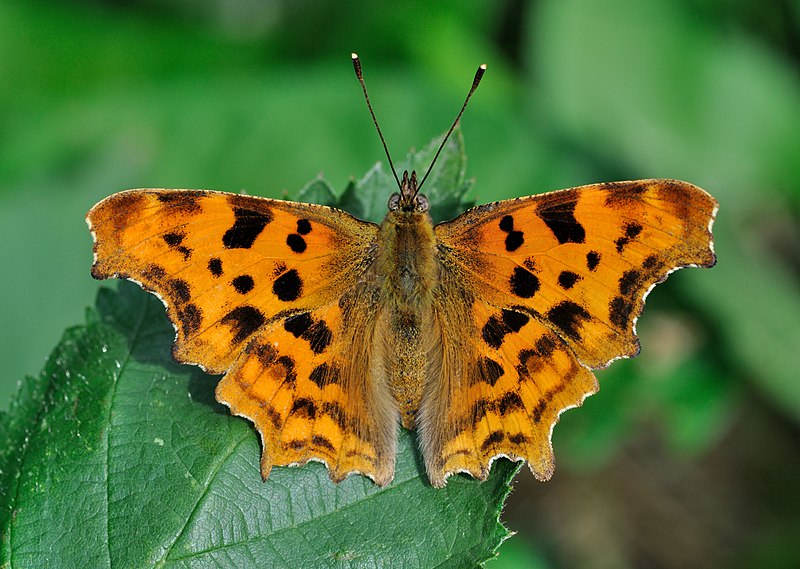
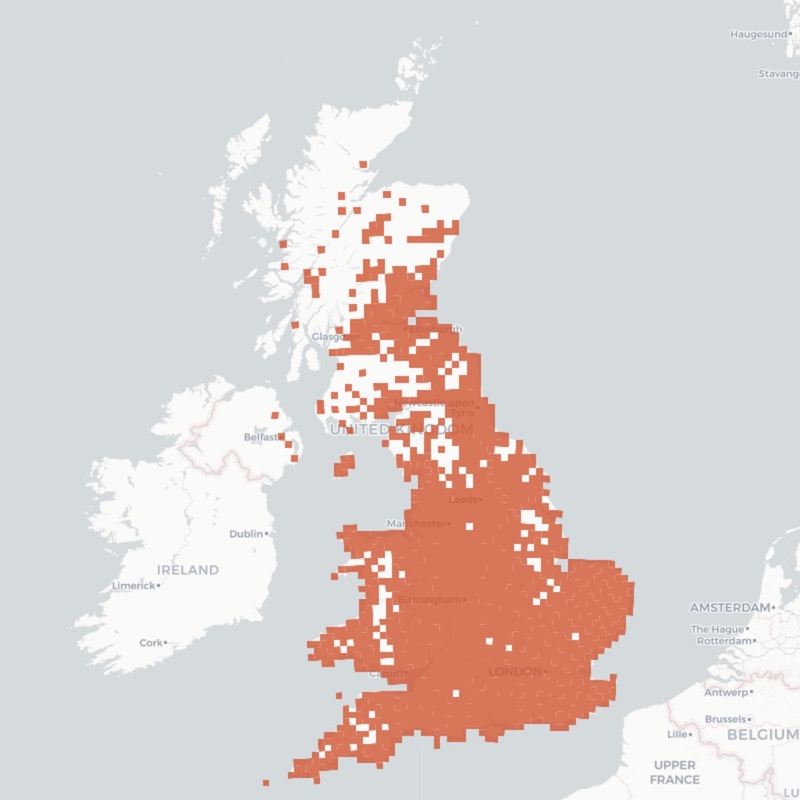
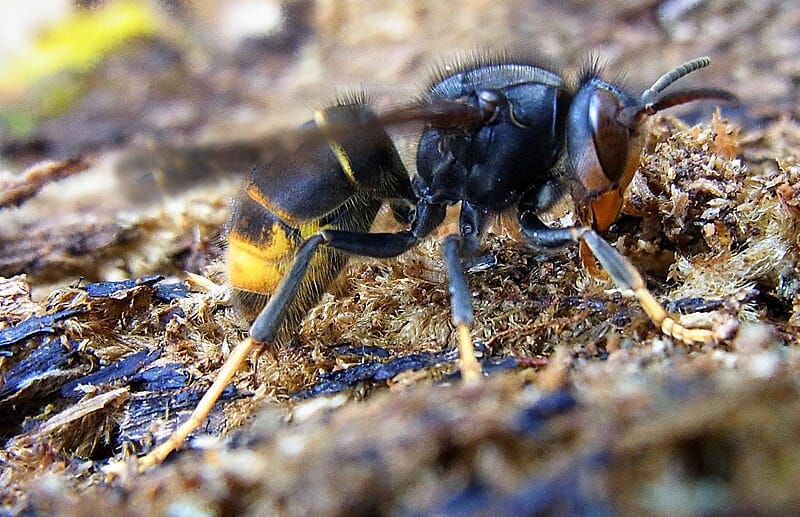
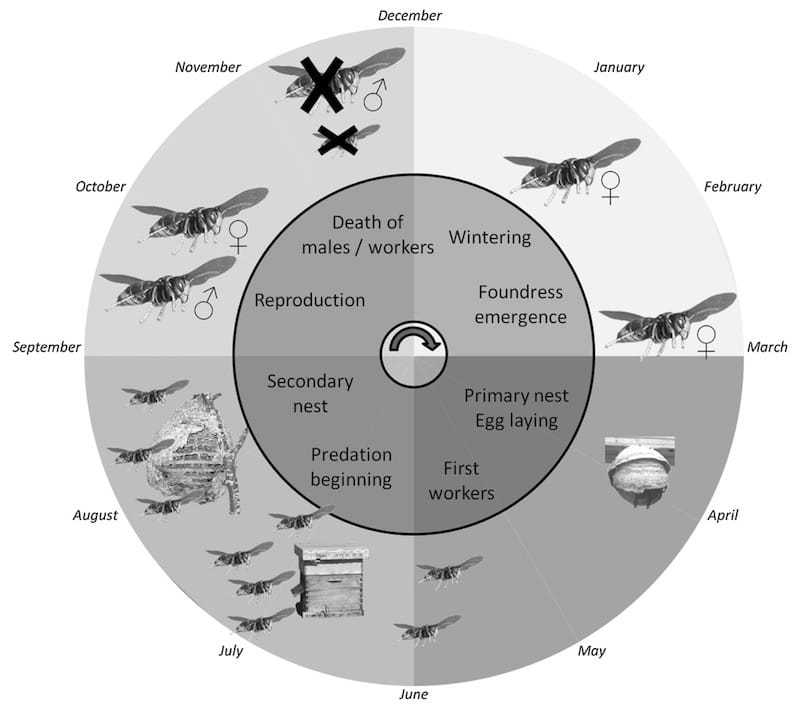
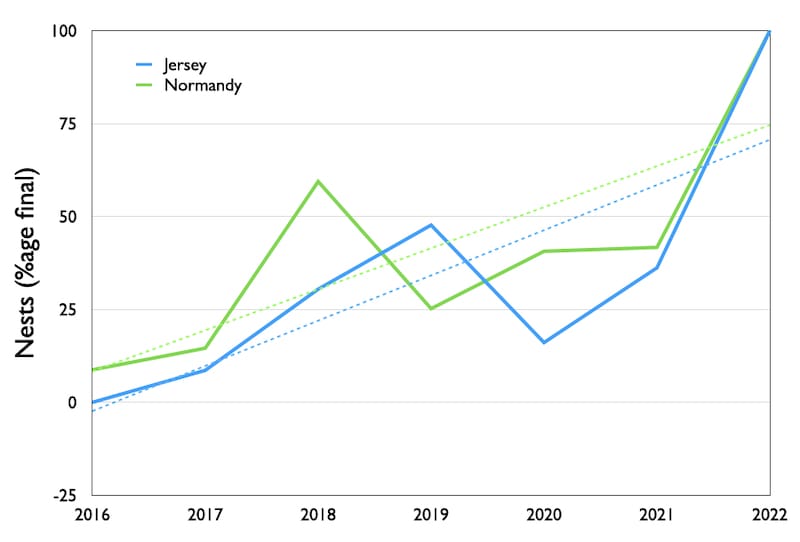
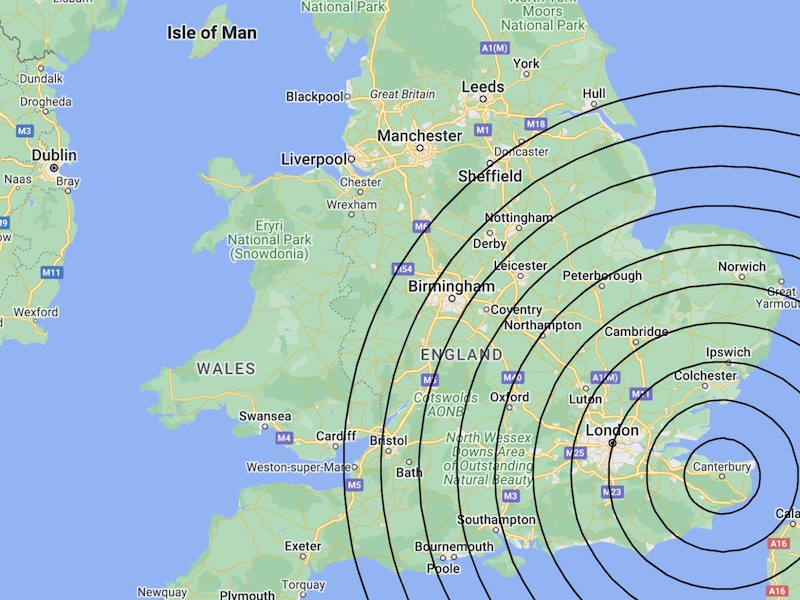
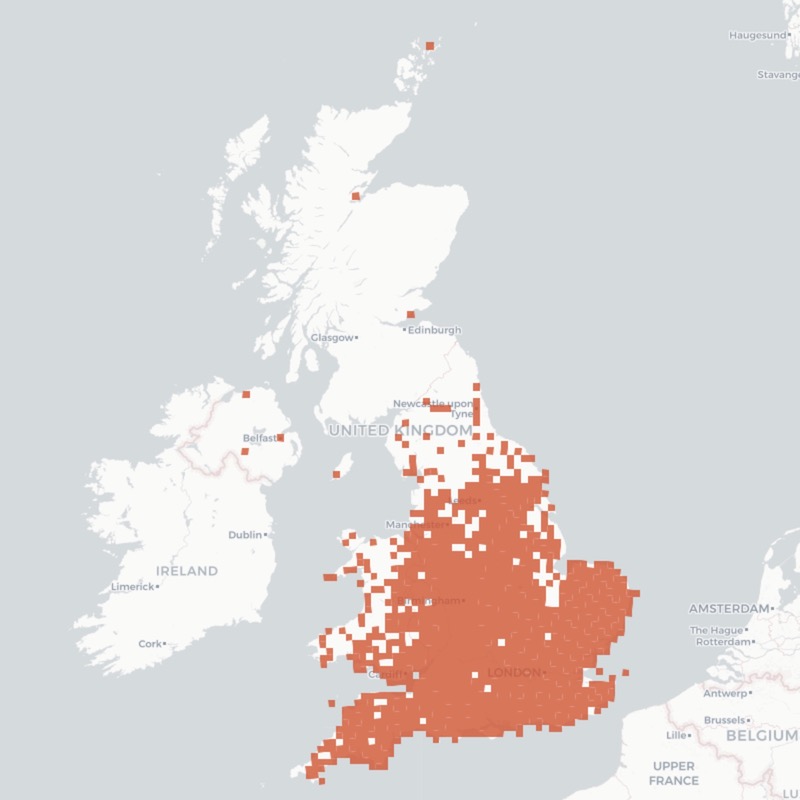
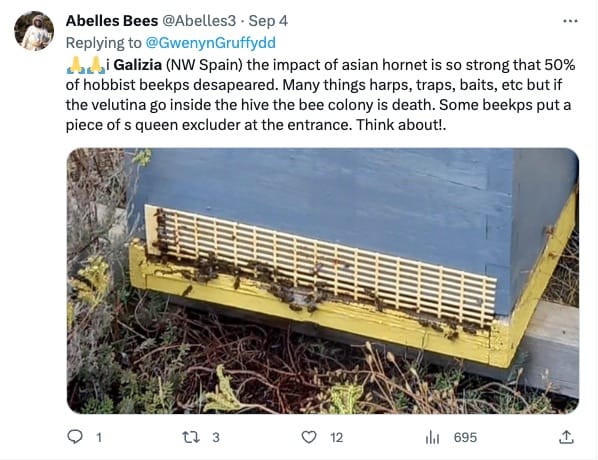
Join the discussion ...